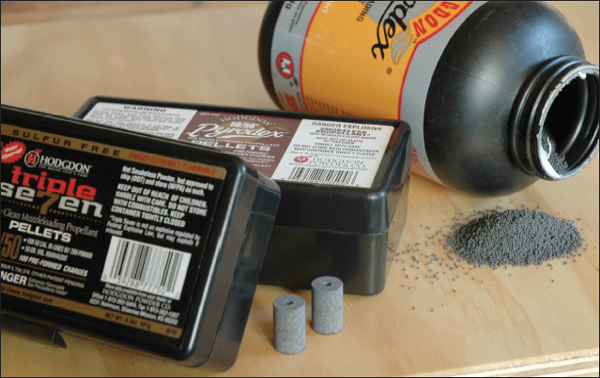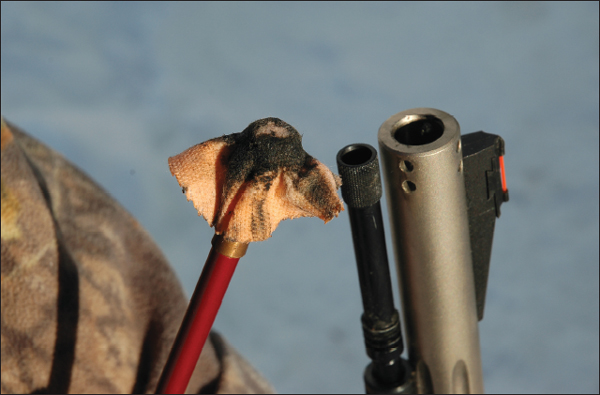12. Not Quite Black Powder
In 1976 Hodgdon agreed to distribute a new product called Pyrodex, a black-powder substitute that had its start far from Missouri, in the Seattle-area laboratory of a gifted young shooter named Dan Pawlak. Dan’s goal during the early 1970s was to develop a fuel that would match black powder in appearance and density, generate similar smoke and smell, and yield comparable velocities at pressures any black powder gun could handle. The compound would be stable and safe and easy to ship, releasing shippers and shooters from the onerous regulations governing black powder. Pawlak aimed to provide a fuel that would stay outside the Class A, High Explosive category, where the Bureau of Explosives in the US Department of Transportation had placed black powder. Ideally his propellant would pass stringent Flammable Solids tests, so it could be handled like smokeless powder.
Pawlak teamed up with an experienced propellant engineer, Mike Levenson, and within two years the pair developed a steel-gray fuel that met some of Dan’s criteria. The new substance was dubbed Pyrodex, an abbreviation for pyrotechnic deflagrating explosive.
Pawlak’s work caught the eye of Warren Center at the gun firm of Thompson/Center. He phoned R. E. Hodgdon and urged him to consider a joint financial venture backing the young man. In January, 1975, Hodgdon traveled to Seattle and found the strapping 6’4” entrepreneur in his Issaquah mobile home, next to a private airstrip and a remarkably well-equipped ballistics laboratory. After examining the transducer pressure guns, oscilloscopes, and other sophisticated devices, R. E. knew Pawlak was both serious and talented. A quick study of pressure curves and some test firings convinced him that Pawlak was also onto something.

Pyrodex, developed by Dan Pawlak then marketed by Hodgdon, was updates as pellets. Triple Seven pellets followed.
By this time Mike Levenson had left the project. With underwriting from Linn Emrich, Dan Pawlak continued to accumulate equipment, most of it used. He refined Pyrodex, increasing its potency, reducing its range of pressure variation, making it burn cleaner, adjusting components to make it smell like black powder. He even changed the color to black. And he began to remodel a former explosives facility, Excoa, on Taylor Mountain north of Issaquah, for Pyrodex production.

Cleaning muzzle-loaders frequently not only improves accuracy; it makes them easier to load.
Before submitting Pyrodex to government tests, Pawlak arranged his own. The detonator trials were most severe: An igniter was placed in one canister of 10 one-pound canisters in a case. The case was covered and surrounded with similar cases of the same size and weight but containing sand. To pass the test, the ignited can could not cause detonation in the others. Even smokeless powders occasionally fail this exercise. Pawlak, however, added rigor to the trial: He put a detonator in each can in the center case! Noise and flame ensued when the Pyrodex burned, but there was no detonation. In fact, the subsequent Department of Transportation laboratory report stated that “Pyrodex is probably a little safer than conventional smokeless powder because the ignition temperature is considerably higher.”
Pawlak targeted the first shipment from Pyrodex Corporation for May, 1976. Hodgdon agreed to be the sole distributor for Pyrodex, and to market it as “the replica black powder.” The launch gained momentum when Pyrodex was approved by the National Muzzleloading Rifle Association for use in NMLRA matches. Then, on January 27, 1977, tragedy struck the entrepreneur who had done what many thought impossible. At the Issaquah plant, three tons of Pyrodex flashed off, killing Dan Pawlak and three technicians..
In the aftermath, Pyrodex was again tested. Again, it was found to be less hazardous than smokeless propellants. The directors of Pyrodex Corporation met with Mrs. Pawlak and the board of Hodgdon Powder Company to discuss the product’s future. Though initial demand had been strong, the Issaquah disaster would certainly affect shooters’ perceptions. Still, the outcome of that somber January meeting in Issaquah may never have been in doubt. Dan Pawlak had been convinced his propellant would not only make money but encourage more people to take up black powder shooting. He also believed it would make the sport safer. Cathy Pawlak, Linn Emrich, Dave Wolfe, Neil Knox, and R. E. and J. B. Hodgdon agreed to build a new Pyrodex mill on an abandoned B-29 base eight miles from Herington, Kansas, 130 miles from Hodgdon’s distribution center. In May, 1979, after three years and numerous delays, the $1.5 million plant began turning out canisters of Pyrodex. They reached retail stores in early 1980.
Pyrodex soon became available in three grades: RS, the equivalent to FFg black powder which works best as the main charge in most muzzle-loading rifles; P, which mimics FFFg in burning characteristics and is for small-bore rifles and pistols; and Pyrodex “Select” which appeared in 1991 as a specialty powder for sabot and heavy conical bullets. In 1997 Hodgdon announced Pyrodex pellets, 50-grain (equivalent) pills easy to pop into the muzzle. Use two or three for 100-and 150-grain charges. No measuring required.
The generation of black-powder enthusiasts now thumbing hammers in the field or at rendezvous shoots may not remember Dan Pawlak. They certainly know about Pyrodex. Legions would say it’s the best fuel ever to feel the tamp of a ramrod. Dan would have liked to hear that.

Not many hunters see bucks this big, let alone shoot one with a muzzle-loader! Where? Illinois.
Table of contents
- Title Page
- Dedication
- Copyright
- Acknowledgments
- Foreword
- CONTENTS
- INTRODUCTION
- SECTION I: BALLISTICS IN HISTORY
- SECTION II: THE MUSCLE BEHIND THE SHOT
- SECTION III: BULLETS—THE INSIDE STORY
- SECTION IV: SPEED, ENERGY, AND ARC
- SECTION V : PUTTING BALLISTICS TO WORK
- SECTION VI: FOR LONGER REACH
- BALLISTICS TABLES FOR MODERN SPORTING RIFLES
- GLOSSARY